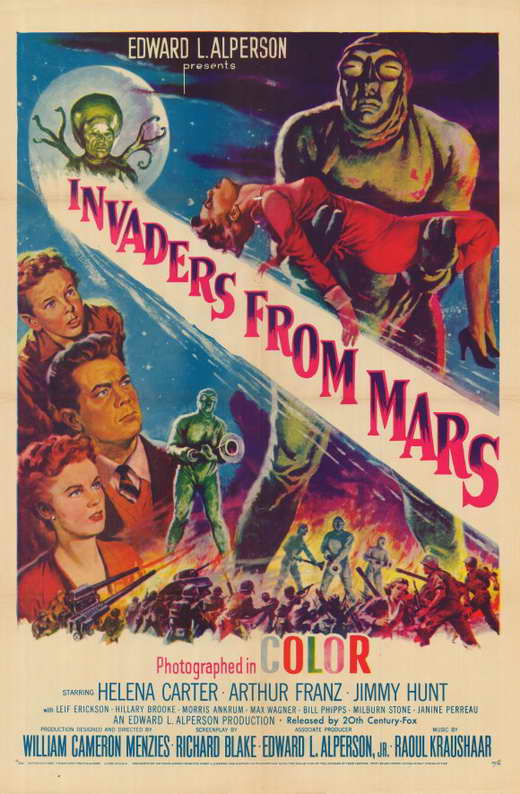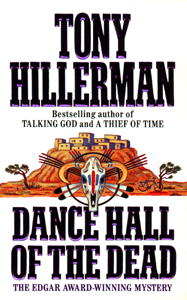 Do you know what day it is? A hint: take a look at the interactive Google doodle.
Do you know what day it is? A hint: take a look at the interactive Google doodle.Sixty-six years ago today, the information officer at the Roswell Army Air Field in New Mexico issued a press release stating that a flying disk had been found on a ranch near Roswell. Hours later, the RAAF said that the debris came from a weather balloon. Thus began the myth that an alien spacecraft had crashed at Roswell, that aliens had been autopsied, and that the US government was covering it all up.
I've never been a Roswell conspiracy believer, but I've been a fan of movies and novels involving visitors from outer space since I was a kid. On a list of my most traumatic childhood experiences is the TV viewing of the 1953 movie, Invaders from Mars. That movie begins when a young boy climbs out of bed to witness a flying saucer landing outside his window. Soon, humans become vessels for the hostile aliens; you can tell whose body has been taken over by a mark on the back of the neck. Eventually, the boy helps to save the world. As the movie ends, all seems well, until the boy once again climbs out of bed to peer out the window. Wouldn't you know it, here comes a flying saucer again.
I'll be celebrating Roswell's 66th anniversary tonight with a re-watching of John Carpenter's 1984 movie, Starman, in which Jeff Bridges, playing a sweet alien who answers a Voyager 2 invitation to visit Earth, takes on the appearance of Karen Allen's recently deceased husband. It's a great sci fi/road movie/romance that fittingly travels through Las Vegas and ends in the American Southwest.
You may prefer to watch an episode of Doctor Who; The War of the Worlds (the 1953 version is best); ET the Extraterrestrial; District 9; The Rocky Horror Picture Show; or the charming Galaxy Quest, involving a group of appealing Thermians, who swoop down to Earth to pick up the crew of a cancelled TV series resembling Star Trek, because the Thermians desperately need their help dealing with the evil outer-space warlord, Sarris.
If you'd rather read about alien visitors than watch them, you could try a book we Material Witnesses have enjoyed: Rob Reid's Year Zero (mentioned here by Sister Mary Murderous; her Amazon review is here); or Jack Finney's 1955 novel, Invasion of the Body Snatchers. In that book, the author of Time and Again envisions seeds from outer space becoming pods near the fictional town of Santa Mira, California. In the pods grow perfect replicants of sleeping people who, when replaced, crumble to dust while their replacements live for 5 years. This book formed the basis for several movies. The 1953 movie's screenplay was written by Daniel Mainwaring, who also wrote the screenplay for the noir masterpiece Out of the Past; it stars Kevin McCarthy and Dana Wynter. The 1978 remake of Invasion of the Body Snatchers stars Donald Sutherland, Leonard Nimoy, and Jeff Goldblum. I enjoyed them both.
 A third fun book is Robert Jackson Bennett's American Elsewhere, published by Orbit in February 2013.
A third fun book is Robert Jackson Bennett's American Elsewhere, published by Orbit in February 2013.Bennett's 38-year-old Latina protagonist, tough ex-cop Mona Bright, has left Houston and is drifting around when she learns her dad has died, and she has inherited his cherry-red Dodge Charger and her long-dead mother's house in Wink, New Mexico. The terms of the will give her 11 days in which to claim her inheritance in Wink.
The facts that Wink doesn't appear on any map and no tax assessor has ever heard of it are only Mona's first pointers that the picture-perfect community, created when the now-shuttered Coburn National Laboratory and Observatory was established on a nearby mesa, isn't your typical small American town. Then comes the hotel, whose last guest arrived decades ago. The proprietor, Mr. Parson, seems to play Chinese checkers with himself, and he warns Mona that it's best to stay inside at night. Over the course of this 662-page book, Mona makes a few important discoveries: all unhappy families are not alike, time and place aren't as fixed as she once thought, and Wink inhabitants have varying takes on how to live the American dream. While the last third of the book is a bit repetitious, this is a thought-provoking and entertaining read. The best book ever for a summer thunder storm.
No matter how or with whom you spend this anniversary evening, I'm sure you'll remember that you're only human.


































